Bank Levy
After you’ve won your lawsuit and received a judgment against the other party, your next step is to attempt to collect what you’re owed. The court does not collect your judgment for you– as the judgment creditor, this is your job.
If the judgment debtor has a bank account, you may be able to take money from the account, using a process called a “bank levy.” An account held jointly by the judgment debtor and his or her spouse or another person, or held solely by the judgment debtor’s spouse, may also be levied.
Templates and Forms
- Writ of Execution (EJ-130)
- Declaration (MC-030)
- Notice of Opposition to Claim of Exemption (WG-009/EJ-170)
- Notice of Hearing on Claim of Exemption (WG-010/EJ-175)
- Request for Sheriff to Serve Court Papers (SER-001)
- Special Instructions for Writs and Levies—Attachment (SER-001A)
Step-by-Step Instructions
1
Locate the Judgment Debtor’s Bank Account(s)
Locate the Judgment Debtor’s Bank Account(s). You can guess which banks the debtor may have accounts with and attempt to levy them–some creditors will levy several major banks in hopes of finding an account. But you can also find out what bank the debtor uses by requesting the information at a debtor’s examination.
2
Obtain a Writ of Execution
To levy the debtor’s bank account, you must ask the court to issue a writ of execution. This is a court order instructing the Sheriff to enforce your judgment in the county where the assets are located.
2.1 Complete the Writ of Execution (EJ-130) form
To levy a debtor’s bank account, you must ask the court to issue a writ of execution. This is a court order instructing the Sheriff to enforce your judgment in the county where the assets are located. This may be a different county from the one that issued the judgment, or where the party lives. The Judicial Council form used to obtain a writ of execution is:
Instructions for completing this form are available at the end of this Guide.
2.2 Adding Costs and Interest
If you wish to add additional costs incurred after entry of judgment, such as the costs associated with enforcing the judgment (e.g., the cost of issuing the writ of execution, levying officers’ fees, fees for the debtor’s examination, etc.) or accrued interest on your judgment amount, you must file a Memorandum of Costs after Judgment (MC-012) with your Writ of Execution (EJ-130). You must serve your Memorandum of Costs after Judgment (MC-012) on the judgment debtor prior to filing. The judgment debtor has 10 days after service of the Memorandum of Costs after Judgment (MC-012) to oppose it by filing a motion to tax costs (Code of Civil Procedure (CCP) § 685.070(c)). For more information on the procedure and forms, see the Step-by-Step guide on Memorandum of Costs after Judgment.
2.3 Obtain a File-Endorsed Copy of Your Judgment
You will need to provide the court with a file-endorsed (stamped) copy of your judgment. If you do not have one, you may download a copy from the court’s website.
2.4 File Your Documents
File the following items with the court:
- Writ of Execution (EJ-130) (original + 2 photocopies)
- Memorandum of Costs after Judgment (MC-012), if desired (original + 2 photocopies)
- File-endorsed (stamped) copy of the judgment
- Filing fee (currently $40)
File your documents in the drop box at the courthouse at 720 Ninth Street. Fill out and attach the Civil Document Drop-Off Sheet , and date stamp the back of your original documents. Following the instructions posted at the drop box, place your documents in the drop box, along with a check, money order, or cashiers’ check for the filing fee. Provide the court with a self-addressed stamped envelope with sufficient postage to facilitate the return of your documents to you.
If you filed a Memorandum of Costs after Judgment (MC-012) along with your Writ of Execution (EJ-130), and your costs are more than $100, the clerk will wait 10 days (15 days, if served by mail) to issue Writ of Execution, to allow the judgment debtor to oppose your costs by filing a Motion to Tax Costs (CCP § 685.070). If your costs are less than $100, or if you did not file a Memorandum of Costs, your Writ can be issued immediately. The clerk will return the issued documents to you by mail. Your Writ of Execution (EJ-130) will be valid for 180 days after it is issued.
3
Obtain Supporting Documents, if Needed
In some special situations, the levying officer will ask for additional documentation in order to levy a bank account.
Spousal Affidavit
California law (CCP § 700.160(b)) allows a judgment creditor to collect money from the bank account in the name of the debtor’s spouse even when the debtor’s name is not on the account. To do this, the judgment creditor must provide a declaration under oath to the levying officer, stating that the person whose account is to be levied is married to the judgment debtor. You may use Declaration (MC-030) to write this statement. A sample affidavit is available at the end of this Guide.
Fictitious Business Name Statement
Accounts in the judgment debtor’s Fictitious Business Name (e.g., Robert Jones DBA Jones Enterprises) may be levied if the business is registered solely in the names of the debtor and/or debtor’s spouse. If a third party is also registered, the account cannot be levied. To levy this type of account, you will need to provide an unexpired, certified copy of a fictitious business name statement. To obtain certified copies of these statements for Sacramento County businesses, visit the Department of Finance’s Business License Unit, located at 700 H Street, Room 1710.
4
Determine When to Have Your Levy Served
Unlike other paperwork in your case, bank levies can only be served by a Sheriff or registered process server. A bank levy is a one-time event, and only attaches the funds in the account at the time the bank is served. Therefore, timing service of your levy can be very important – you will want your papers served on a day when there is a lot of money in the account. For this reason, some judgment creditors prefer to have a registered process server (rather than the Sheriff) serve the bank, so they can specify the exact date for service. You can find registered process servers in the Yellow Pages or from the directory of the National Association of Professional Process Servers. If you hire a process server, they will be responsible for delivering documents to the bank, judgment debtor, other account holders, and the Sheriff. The Sheriff’s Department will handle all other aspects of the bank levy, including receiving and releasing funds.
When considering when to have your levy served, keep in mind that your writ of execution must be valid at the time of service. Writs of execution are valid for only 180 days after issued by the court.
5
Determine Where to Have Your Levy Served
California law (CCP § 684.115) requires all financial institutions with 10 or more branches to designate a central location for service of process. This is optional for institutions with fewer than 10 branches. A list of these central locations for service on banks is available online. The Sheriff in the county where the institution receives service will act as the levying officer. Contact information for Sheriffs throughout California is available online. If you plan to hire a process server to serve your levy, be sure to ask if they will perform service in the county where the financial institution accepts service.
6
Complete the Levy Instructions
The Writ of Execution (EJ-130) simply tells the Sheriff to enforce a judgment, but does not specify the method(s) to be used. You must provide details of how they are to enforce your judgment.
]To enforce your judgment with a bank levy, you must provide the levying officer (Sheriff) with information about the debtor’s account(s). There is a California state-wide form for these instructions, Request for Sheriff to Serve Court Papers (SER-001) for use with Special Instructions for Writs and Levies—Attachment (SER-001A).
The Sacramento County Sheriff’s Department has posted Documents and Mail Guidelines for turning the instructions and paperwork in. If service will be performed by a registered process server, or by the Sheriff in a different county, ask how they would like to receive their instructions.
7
Have Your Writ Served
To have your documents served by the Sacramento County Sheriff, bring the items listed below to the Sheriff’s Civil Division, 2969 Prospect Park Drive Suite 200, Rancho Cordova, CA 95670. You can also file over the internet at the Sacramento County Sheriff’s E-Services Portal.
The Sacramento County Sheriff can only perform service within Sacramento County; if the institution is located in a different county, you will need to contact either the Sheriff of that county or a registered process server. Ask your server what he or she will need.
You will likely need the following documents:
- Original Writ of Execution (EJ-130)
- Request for Sheriff to Serve Court Papers (SER-001) with Special Instructions for Writs and Levies—Attachment (SER-001A) or Letter of Instruction for the process server
- Cash or check for the Sheriff’s fee (currently $50 for each person or organization served). This is the fee for having the Sheriff process the levy; it must be paid even if a registered process server will be serving the documents. Check the Sheriff’s fee schedule for up-to-date charges.
As applicable, also include:
- Original + 2 photocopies of your Spousal Affidavit
- Certified copy+ 2 photocopies of Fictitious Business Name Statement
If you hire a process server, the process server will bring the required documents to the appropriate Sheriff’s Department, open a file, and have a Levying Officer’s file number assigned.
Based on the information on your Writ, the process server or Sheriff will complete a Notice of Levy (EJ-150) for the bank, the judgment debtor, and any other named account holders. Upon the Notice of Levy (EJ-150) will be a Levying Officer’s file number. You can use this number to track the status of your file at on the Sheriff’s website.
To initiate the bank levy, the Sheriff or process server will serve the bank with:
- Copy of the Writ of Execution (EJ-130)
- Notice of Levy (EJ-150)
- A blank Memorandum of Garnishee (EJ-152), for use by the bank
Once served with these documents, the bank must freeze non-exempt account(s). This means that no withdrawals may be made, and no checks written against the account will be honored.
At the time of the levy, or promptly thereafter, the Sheriff or process server will serve the judgment debtor with:
- Copy of the Writ of Execution (EJ-130))
- Notice of Levy (EJ-150) (addressed to bank)
- Notice of Levy (EJ-150) (addressed to debtor)
- Exemptions from the Enforcement of Judgments (EJ-155)
The Sheriff or process server will serve any other named account-holders with:
- Copy of the Writ of Execution (EJ-130)
- Notice of Levy (EJ-150)
- A blank Memorandum of Garnishee (MC-152), for use by the account holder
The process server will complete a Proof of Service for each person or organization served, and return those, along with the original Writ of Execution (EJ-130), to the Sheriff.
The bank has 10 days to turn over the funds to the Sheriff, or to complete the Memorandum of Garnishee (EJ-152) and return it to the Sheriff. On this form, they must explain why the judgment debtor’s funds cannot be released. For example, funds cannot be released if another judgment creditor has already served a levy on the same funds, or if the account has a $0 balance. A bank will commonly submit a Memorandum of Garnishee (EJ-152) when it is aware that the account receives direct deposits of Social Security or other public benefits. If the bank completes a Memorandum of Garnishee (EJ-152), the Sheriff will mail a copy to the judgment creditor.
8
Wait for Response from the Debtor, if Any
Under state and federal law, some types of income and property are exempt from collection. If the Memorandum of Garnishee (EJ-152) indicates that the account includes exempt funds, such as Social Security benefits, the Memorandum of Garnishee (EJ-152) serves as a claim of exemption. Additionally, if the judgment debtor or other account holder believes his or her funds are exempt, that person has 15 days (20 days if served by mail) after receiving the Notice of Levy (EJ-150) to file a Claim of Exemption (EJ-160) with the Sheriff’s Department to prevent the levy. The Sheriff will mail the judgment creditor a copy of the Claim of Exemption (EJ-160) and Financial Statement (EJ-165).
9
Oppose the Claim of Exemption, if Appropriate
Be sure to review the Claim of Exemption (EJ-160) and Financial Statement (EJ-165) carefully, to determine if you agree that the funds are exempt from collection. You can read about most of these exemptions in Exemptions from the Enforcement of Judgments (EJ-155). A guide to common exemptions, with links to the applicable code sections, is available on the Law Library’s website.
If you agree that the funds are exempt, you do not need to do anything. After 10 days, the exemptions are automatically granted and the funds claimed exempt will be returned to the debtor. If you do not believe the funds are exempt from collection, and decide to oppose the claim of exemption, you must act quickly. There is an extremely tight turnaround on the deadlines for oppositions.
Step 9.1 Determine when to schedule your hearing.
In Sacramento County, you are responsible for reserving a hearing date to oppose a claim of exemption. The timing for opposing a claim of exemption can be very tricky. There are three different time periods you have to consider, all of which may overlap.
- Your time to oppose the Claim of Exemption. If you oppose the Claim of Exemption, you must file with the court and serve on the judgment debtor and levying officer your Notice of Opposition to Claim of Exemption (WG-009/EJ170) and Notice of Hearing on Claim of Exemption (WG-010/EJ-175) no later than fifteen (15) days after the Claim of Exemption is served on you by the levying officer (CCP § 703.550). If the levying officer served it to you by mail, five additional days are added (CCP § 1013(a)), but service is still measured from the date of mailing, not the date of receipt.
- Minimum notice to judgment creditor, court, and levying officer of hearing date. If you oppose the Claim of Exemption, you must serve on the judgment debtor and levying officer, and file with court, your Notice of Opposition to Claim of Exemption (WG-009/EJ170) and Notice of Hearing on Claim of Exemption (WG-010/EJ-175) at least 10 days before the date for hearing that you have chosen (CCP § 703.570), however five extra days must be added if you serve it by mail. (CCP § 1013(a))
- Last date opposition can be heard. In addition to the minimum notice required, any hearing opposing a Claim of Exemption for a levy must be heard no later than 30 calendar days after filing of the Notice of Opposition to Claim of Exemption (CCP § 703.570).
Due to the way weekends and court holidays fall, sometimes there is a very narrow window of time in which a hearing may be held. Failure to properly set the hearing and file within the prescribed times is one of the most frequent reasons judgment creditors lose their opposition to a claim of exemption.
For example, let’s say the Sheriff mails the Notice of Claim of Exemption to you on May 3. You have 15 days to serve your opposition to the sheriff and judgment debtor, and file it with the court. The last day to file your opposition is May 18th (shown in Green below). Your hearing must be held within 30 days of filing, so if you file on May 18th, the last day for your hearing is June 18th; the 30th day is June 17th, but since that is a Sunday, the final day is the next court day (California Rules of Court (CRC) 1.10), Monday, June 18th (shown in Blue below).
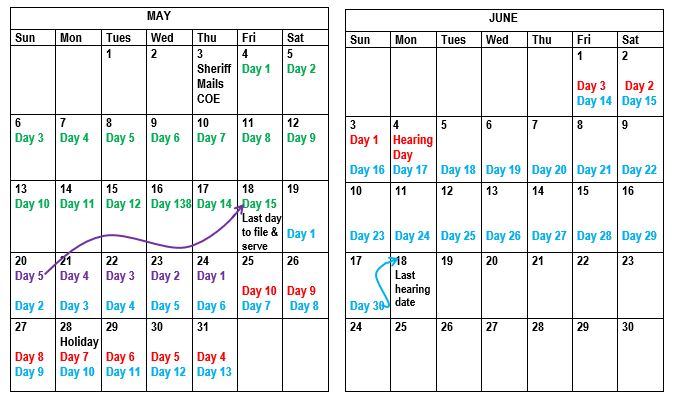
Now comes the tricky part. As the party making this motion, you are responsible for reserving a hearing date. You may select any available date that is convenient for you, as long as it provides the minimum required notice to the judgment debtor.
CCP § 703.570 requires you to provide 10 calendar days’ notice. If you serve your documents by mail within California, you must add 5 calendar days (CCP § 1013 (a)). These days are counted backwards from the hearing date (CCP § 12c). When counting calendar days, include weekends and holidays. If the final day falls on a weekend or holiday, though, your deadline rolls back to the previous court day (CRC 1.10).
In this example, we will use June 4th as our desired hearing date. To confirm that this hearing date will allow sufficient notice, count backward 10 calendar days (shown in Red above). Day one is the day before the hearing date (June 3rd), day 10 in this example is May 25th. This is the last day to serve your documents if personally served, if the date falls within the 10 day window after the Sheriff mailed you the Claim of Exemption (in this example, it does not).
If your documents are served by first-class mail, additional time is added to the calculation, depending on where the mail originates and where it is sent. For example, if the documents are mailed from California to an address in California, five calendar days are added before the 10 calendar days’ notice. Counting backward 5 calendar days makes the last date for service May 20th (shown in Purple above). However, since this day falls on a Saturday, the last date for service by mailing rolls back to the previous court day, Friday May 18th, which happens to be the last date of the window for service after the Sheriff mails the Notice of Claim of Exemption. So if you filed and served your Notice of Hearing on Claim of Exemption and Notice of Opposition to Claim of Exemption (WG-009/EJ-170) on May 18th, you will have provided sufficient notice for a hearing on June 4th.
Some things to remember when selecting a hearing date:
- Filing and service need not occur on the same day. Both must occur within the 15 days after the Sheriff mails you the claim of exemption, and service must be performed on a date that provides sufficient notice (minimum 10 days if personally served, plus an additional 5 days if served by mail.)
- You may give more than the required 10 days’ notice. As a practical matter, providing more than the minimum notice may be preferable, as it reduces the possibility of the court dropping the hearing due to insufficient notice (whether correct or not), or of the opposition making an equitable argument that the notice period was insufficient to prepare, which could lead to a continuance.
Step 9.2 Determining the Department to Hear and the Time of the Motion
In Sacramento, Oppositions to Claims of Exemption are heard in the Law and Motion departments, Dept. 53 and Dept. 54. You must reserve your hearing date online at Hearings are held Tuesday through Thursday. Dept. 53 hears motions at 1:30 p.m. and Dept. 54 at 9:00 a.m. These departments are not in the main courthouse; they are at the Hall of Justice Building, 813 6th Street.
To determine whether your motion is in department 53 or 54:
- Starting with February, 2024, cases are assigned Law and Motion department when they are filed, and it will be indicated in the online case file.
- For cases filed between January 1, 2013 and February 2024: If your case number is ends in an odd number, then your law and motion department is 53; even-numbered cases are in department 54.
- All Law and Motion matters for cases filed prior to January 1, 2013 shall be heard by the Law and Motion department previously assigned.
Step 9.3 Reserve your Hearing Date
All hearing dates must be reserved in advance on the Sacramento County Court’s Case Portal before submitting moving documents to the Court, or by calling the appropriate department on Monday through Friday, 8:30 a.m. to 4:00 p.m. (closed from 12:00-1:00).
- Department 53 – 916-874-7858
- Department 54 – 916-874-7848
Any motion submitted without a reserved hearing date will be subject to rejection.
Step 9.4 File and serve your documents
To oppose a claim of exemption, you must complete two forms:
- Notice of Opposition to Claim of Exemption (WG-009/EJ-170)
- Notice of Hearing on Claim of Exemption (WG-010/EJ-175)
Make 3 copies of each form. File the forms at the filing counter at the Hall of Justice Building, 813 Sixth Street, Room 212. The clerk will stamp your documents and return the photocopies to you. One photocopy is for your records. One photocopy of each document must be given to the Sheriff, so that the funds will be held until the court makes a decision. The third photocopy must be served on the judgment debtor (or the judgment debtor’s attorney). The server must complete a proof of service form, typically either a Proof of Personal Service (POS-020) or a Proof of Service by First Class Mail (POS-030). For more information on these Proofs of Service, see the guides on Personal Service and Service by Mail on our website.
You must include notice of the tentative ruling system with your documents (see Step 10). You can create your own notice on pleading paper, using the language for this notice available from the Sacramento County Superior Court’s website. Or, you may place the tentative ruling language on an Additional Page (MC-020), and attach it to your Notice of Hearing. You can download a pre-filled Additional Page from the Law Library’s website.
10
Check Your Tentative Ruling
Sacramento Superior Court uses a Tentative Ruling System. Pursuant to Local Rule 1.06, the court will make a tentative ruling on the merits of your matter by 2:00 p.m. the court day before the hearing. You may read the tentative ruling online, or may call the clerk for Department 53 at (916) 874-7858 or Department 54 at (916) 874-7848 to hear it.
In the tentative ruling, the judge will determine what funds, if any, are exempt from collection. The ruling will typically order the release of non-exempt funds to the creditor.
If you are happy with the tentative ruling, you do not need to do anything. You won’t have to go to court unless ordered to appear in the tentative ruling or unless the other side calls you and the court between 2:00 p.m. and 4:00 p.m. the court day before your hearing date to request an oral argument in front of the judge. If that happens, attend the court hearing and be prepared to argue your case.
If you are not happy with the tentative ruling, and wish to present arguments in front of the judge, you must call all opposing counsel and/or self-represented parties, and the clerk for Department 53 at (916) 874-7858 or Department 54 at (916) 874-7848 no later than 4:00 p.m. the court day before your hearing and state that you are requesting oral argument on the motion. If neither you nor the opposing counsel or self-represented party requests oral argument, the court will simply make the tentative ruling the order of the court, and no oral argument will be permitted.
11
Sheriff Will Release Funds to You
After determining what funds, if any, are exempt, the court will issue an order directing the Sheriff to release the appropriate amount to the judgment creditor.
For help
SH@LL (Self-Help at the Law Library)
609 9th Street, Sacramento CA 95814
(916) 476-2731 (Appointment Request Line)
Services Provided: SH@LL provides general information and basic assistance to self-represented litigants on a variety of legal issues. All assistance is provided by telephone. Visit “What we can help with” for a list of qualifying cases.
Eligibility: Must be a Sacramento County resident or have a qualifying case in the Sacramento County Superior Court.
For more Information
How to Collect a Judgment– California Courts Self-Help Website
California Forms of Pleading and Practice KFC 1010 .A65 C3 (Ready Reference) Chap. 254
Electronic Access: On the Law Library’s computers, using Lexis Advance.
California Practice Guide: Enforcing Judgments and Debts KFC 1065 .A9 S3 Chap. 6D
Debt Collection Practice in California KFC 256 .C83 Chap. 9
Electronic Access: On the Law Library’s computers, using OnLaw.
Enforcing Civil Money Judgments KFC 1065 .C34
Electronic Access: On the Law Library’s computers, using OnLaw.
How to Collect When You Win a Lawsuit In California KFC 1065 .Z9 H69 (Reference) Chap. 8
Matthew Bender Practice Guide: California Debt Collection and Enforcement of Judgments KFC 1065.E5 M38 Chap. 16
Electronic Access: On the Law Library’s computers, using Lexis Advance.
Samples
Writ of Execution
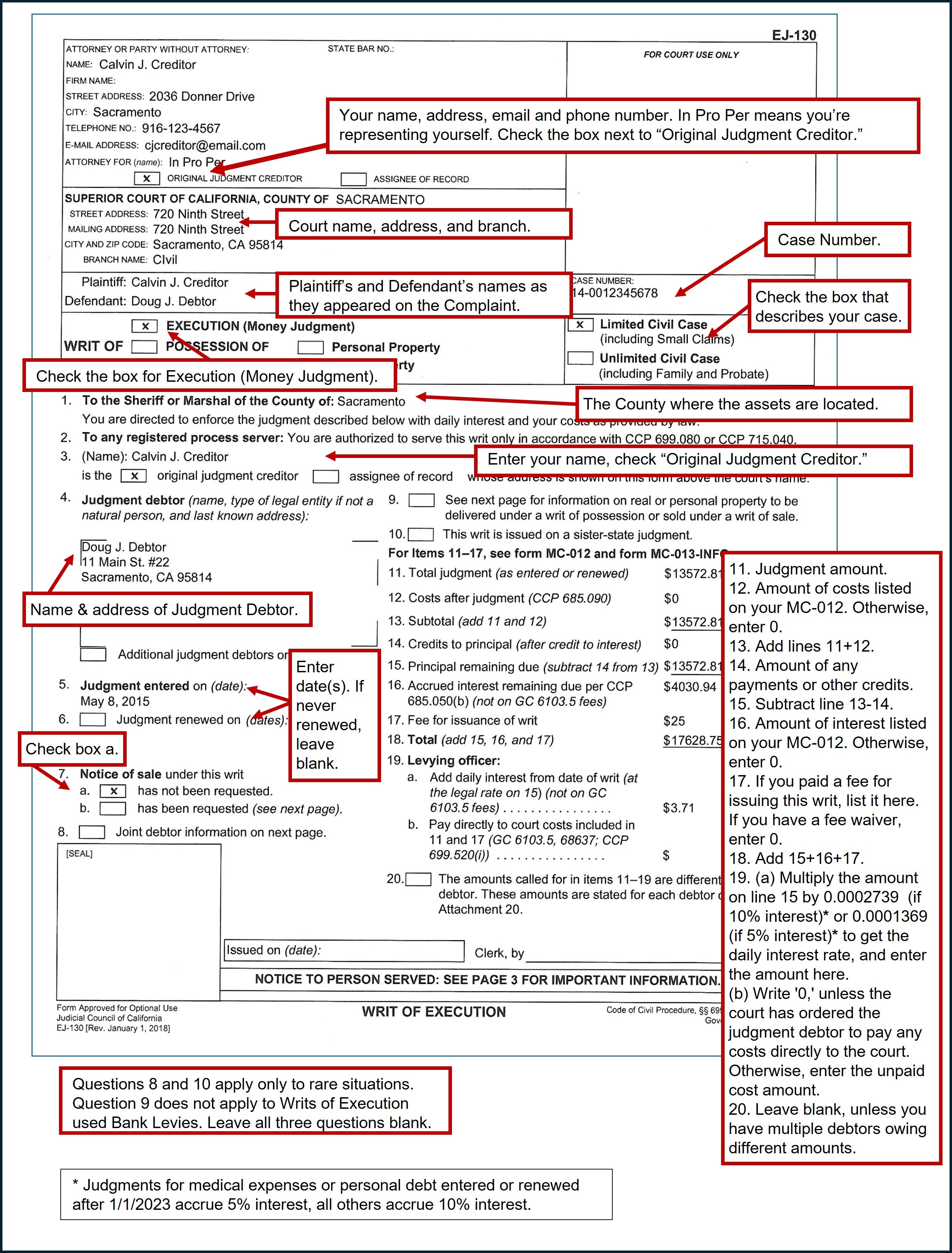
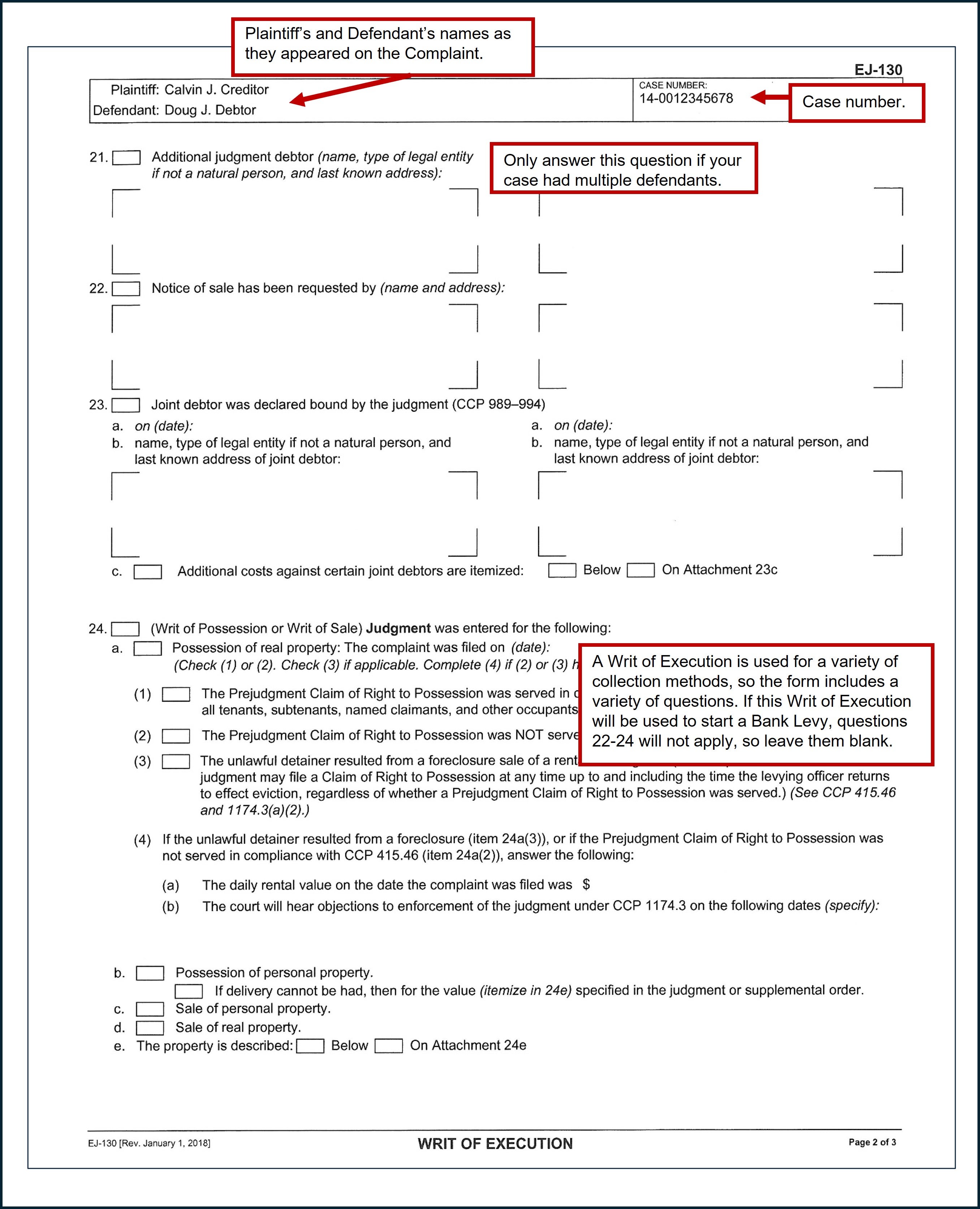
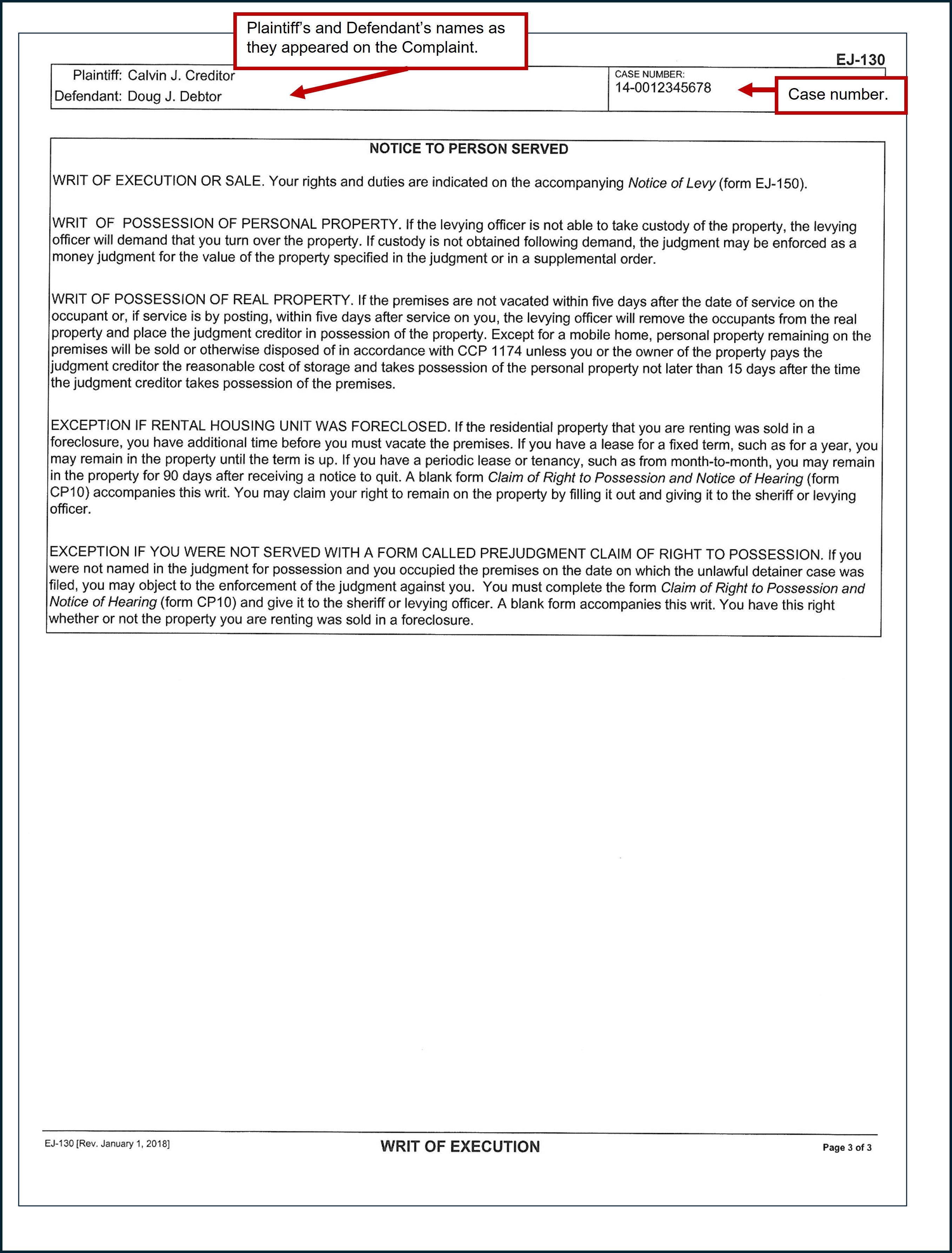
Spousal Affidavit (Optional)
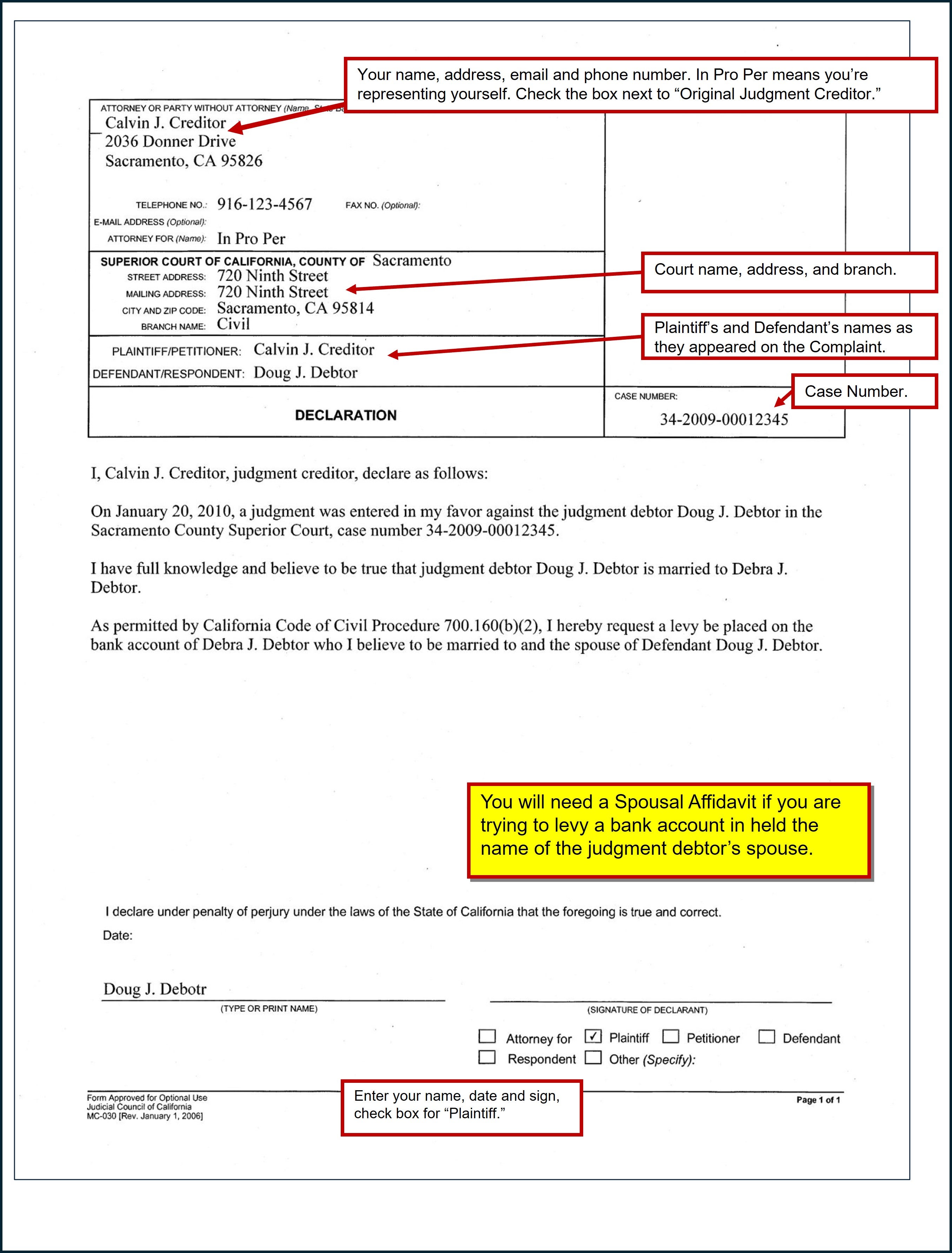
Next steps:
After you provide the Sheriff with the Writ of Execution, the Sheriff will provide a Notice of Levy (EJ-150) and other documents to the bank and to the debtor.
If the debtor makes a Claim of Exemption, the Sheriff will send you a copy of the Claim of Exemption (EJ-160) and Financial Statement (EJ-165). If after you review those documents you feel that the claim of exemption is unjustified, you can set a hearing on the Claim of Exemption. Use the Notice of Hearing on Claim of Exemption to notify the debtor.
Notice of Hearing on Claim of Exemption
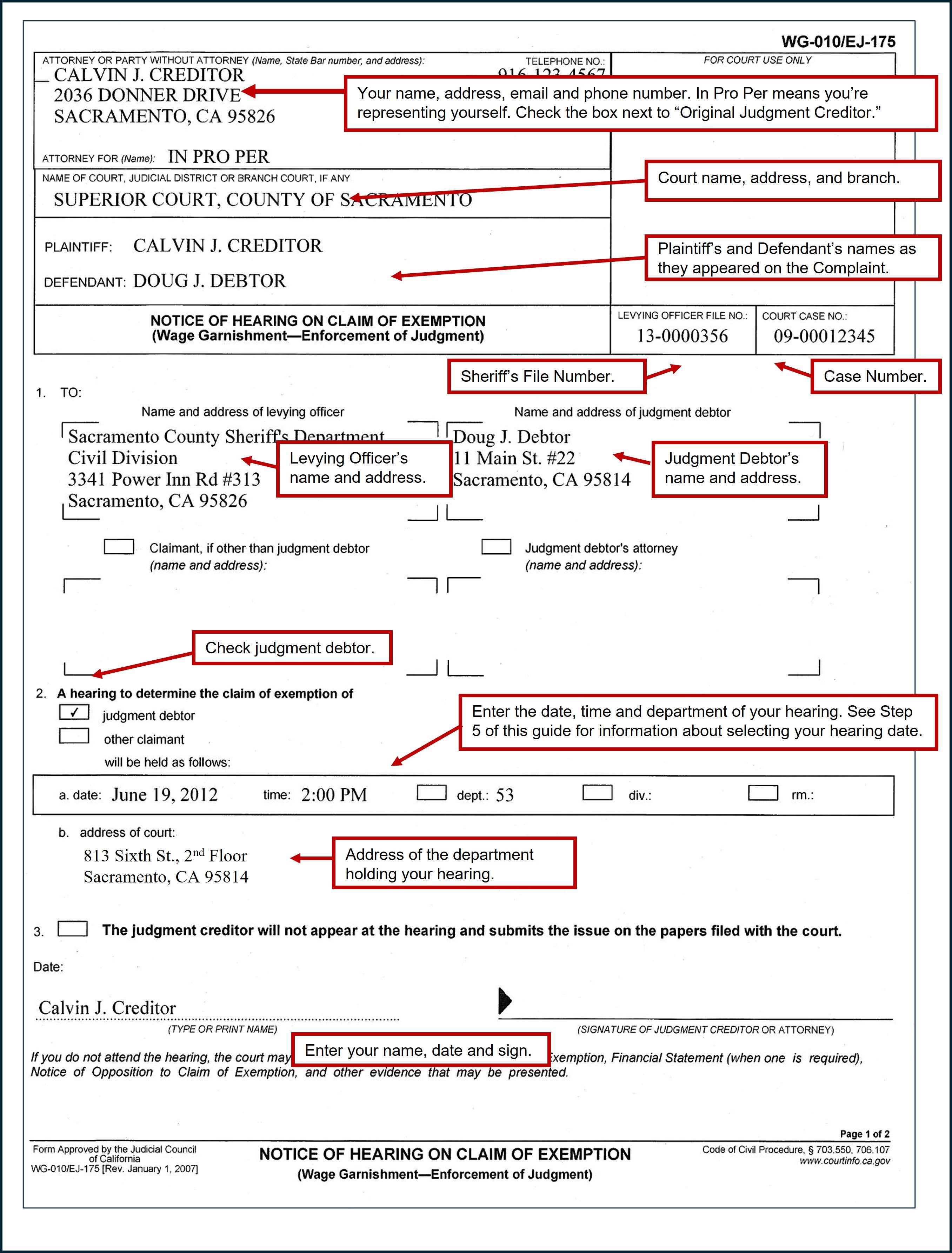
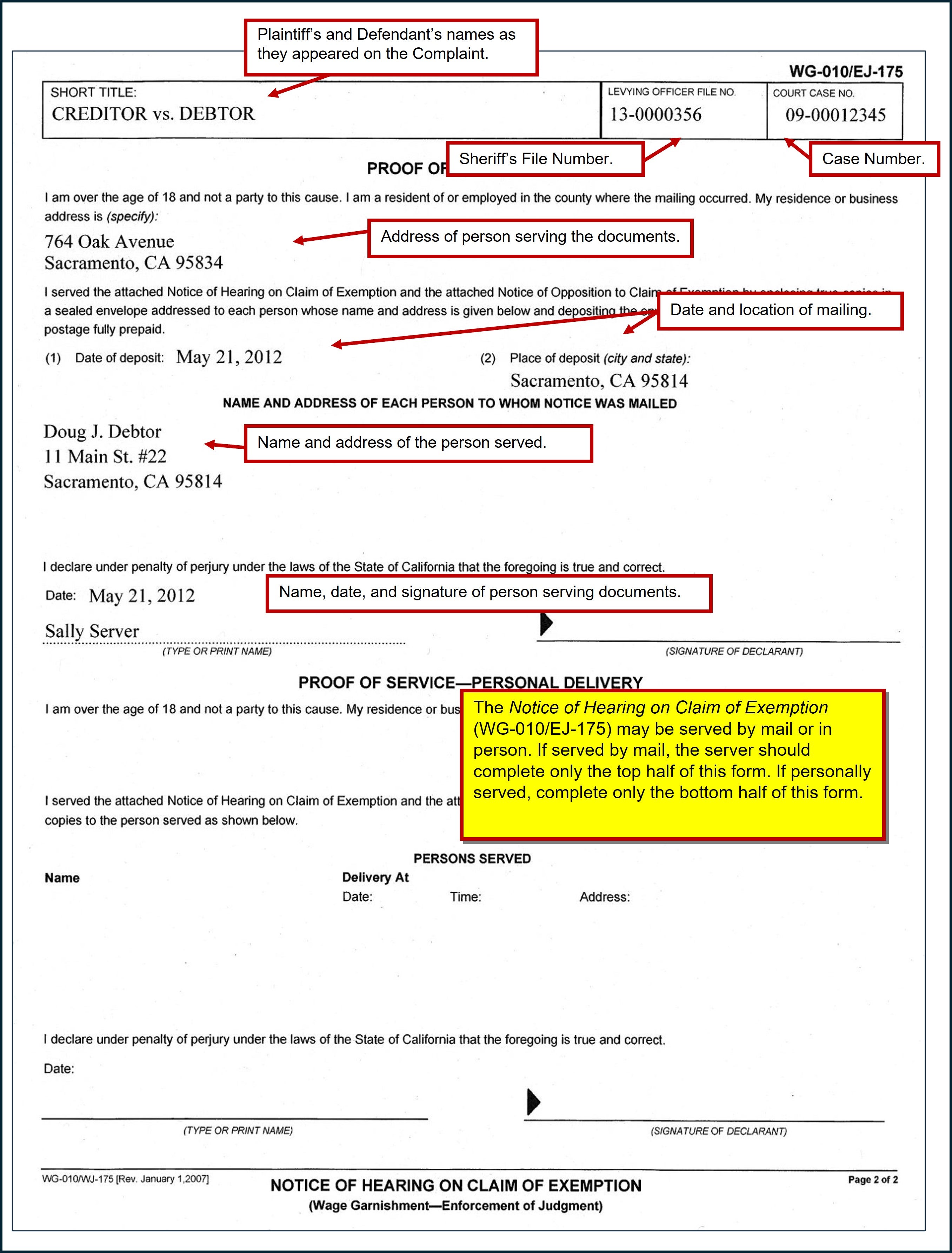
This material is intended as general information only. Your case may have factors requiring different procedures or forms. The information and instructions are provided for use in the Sacramento County Superior Court. Please keep in mind that each court may have different requirements. If you need further assistance consult a lawyer.




